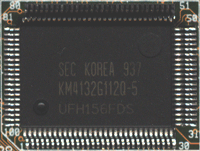We have noticed that most of the GeForce based cards that we have seen are not as eagerly overclocked as NVIDIA's previous generation of processors, the TNT2. One would suspect that the reduced die manufacturer of the processor (.22 micron) would result in a greater overclocking potential because, as a rule of thumb, smaller means cooler and cooler means more overclocking potential. The GeForce processor does not react in the way predicted mainly due to the increased number of transistors that are found on the chip. Increasing the transistor count results in additional heat, thus the amount of heat lost by reducing the chip architecture is made up for by the increased transistor count.
While the V6600 Deluxe comes shipped with the NVIDIA's suggested core speed, this was not originally the plan. When the V6600 Deluxe was first produced, it featured a blazing 150 MHz core and 195 MHz stock speed and the plan was to ship it that way. It was not until NVIDIA requested the change be made that ASUS lowered the clock speeds down to the suggested speeds. Knowing this fact, we wanted to see how much we could push out of the card. The other GeForce cards that we have seen have been able to reach a maximum processor speed of about 150 MHz, so we suspected that the V6600 Deluxe would be able to reach this apparent plateau as well. We were very pleased to find that the precisely applied thermal grease and high quality fan allowed us to clock the processor at the unheard of speed of 158 MHz, resulting in the fastest GeForce processor clock speed seen yet.
 Unlike
the processor speed limit found in most other cards, the memory clock seeds
in GeForce based cards are mainly dependent on the speed of the RAM used. Until
now, the other cards we have seen came with 5.5 Ns SDRAM modules. The ASUS V6600
Deluxe, on the other hand, comes with speedy 5 Ns SGRAM chips. The 5 Ns rating
translates in a maximum speed of 200 MHz, well over the stock speed of 166 MHz.
As was the case with the core speed, the original ASUS plan had the SGRAM chips
running at 195 MHz and it was only changed at the request of NVIDIA. Even with
a speed rating of 200 MHz, we were pleasantly surprised to find that when overclocked,
the memory would push up to 208 MHz. This is quite impressive, considering the
fact that the GeForce processor is very picky with memory due to its quick level
of memory saturation.
Unlike
the processor speed limit found in most other cards, the memory clock seeds
in GeForce based cards are mainly dependent on the speed of the RAM used. Until
now, the other cards we have seen came with 5.5 Ns SDRAM modules. The ASUS V6600
Deluxe, on the other hand, comes with speedy 5 Ns SGRAM chips. The 5 Ns rating
translates in a maximum speed of 200 MHz, well over the stock speed of 166 MHz.
As was the case with the core speed, the original ASUS plan had the SGRAM chips
running at 195 MHz and it was only changed at the request of NVIDIA. Even with
a speed rating of 200 MHz, we were pleasantly surprised to find that when overclocked,
the memory would push up to 208 MHz. This is quite impressive, considering the
fact that the GeForce processor is very picky with memory due to its quick level
of memory saturation.
The resulting overclocked card runs at a fast 158 MHz core speed and a 208 MHz memory speed. Stability was not an issue at these speeds, as the card performed a looped 3D test for 24 hours. When overclocked, we held a card that produced the fastest FPS ratings seen yet in any SDR cards.










0 Comments
View All Comments